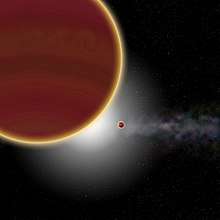Beta Pictoris c
Beta Pictoris c (abbreviated as β Pic c) is the second exoplanet orbiting young debris disk Beta Pictoris, located approximately 63 light-years away from Earth in the constellation of Pictor. It has a mass around 9 Jupiter masses, and orbits at around 2.7 au from Beta Pictoris, about 3.5 times closer to its parent star than Beta Pictoris b,[1] and has an orbital period of 1,200 days (3.3 years).[1] The orbit of Beta Pictoris c is moderately eccentric, with an eccentricity of 0.24.[2]
 Artist's impression of the beta Pictoris system showing the planets in the system. | |
| Discovery | |
|---|---|
| Discovered by | Lagrange et al.[1] |
| Discovery site | La Silla Observatory |
| Discovery date | 19 August 2019[1] |
| Radial velocity method | |
| Orbital characteristics | |
| 1200 d (3.3 yr)[1] | |
| Star | Beta Pictoris |
| Physical characteristics | |
| Mass | ~9 MJ[1] |
Discovery
Beta Pictoris c was detected indirectly, through 10 years of observation[3] of radial velocity data from the High Accuracy Radial Velocity Planet Searcher (HARPS) spectroscope on the European Southern Observatory's ESO 3.6 m Telescope at La Silla Observatory in Chile. Led by Anne-Marie Lagrange and a worldwide team of researchers,[1] this discovery can help scientists further understand the formation of planetary systems and their evolution in the early stages.[4]
Characteristics
Mass, radius and temperature
Beta Pictoris c is a super-Jupiter, an exoplanet that has a radius and mass greater than that of the planet Jupiter; it has a mass of around 9 Jupiter masses (MJ).[1]
Host star
The planet orbits an A-type main sequence star named Beta Pictoris. The star has a mass of 1.75 solar masses (M☉) and a radius of 1.8 solar radii (R☉). It has a surface temperature of 8056 K and is only 12 million years old.[5] It is slightly metal-rich, with a metallicity (Fe/H) of 0.06, or 112% of that found in the Sun.[6] Its luminosity (L☉) is 8.7 times that of the Sun.
Orbit
Beta Pictoris c orbits at around 2.7 au from its host star Beta Pictoris, about 3.5 times closer than Beta Pictoris b.[2] It has an orbital period of 1,200 days (3.3 years).[1]
References
- Lagrange, A.-M.; Meunier, Pascal Rubini; Keppler, Miriam; Galland, Franck; et al. (19 August 2019). "Evidence for an additional planet in the β Pictoris system". Nature Astronomy. doi:10.1038/s41550-019-0857-1. Retrieved 20 August 2019.
- Young, Monica (19 August 2019). "Beta Pic's New Planet, Jupiter's Fuzzy Core & An Ancient Star". Sky & Telescope. Retrieved 19 August 2019.
- "A second planet in the Beta Pictoris system". Nanowerk. 19 August 2019. Retrieved 20 August 2019.
- Narayanan, Nirmal (26 August 2019). "Scientists discover planet 10 times bigger than Jupiter, could help know more about planet formation". International Business Times. Retrieved 12 May 2020.
- Webb, R. A.; Bessell, M. S.; Song, Inseok; Zuckerman, B. (30 October 2001). "The β Pictoris Moving Group". The Astrophysical Journal Letters. 562: L87–L90. doi:10.1086/337968.
- Gray, R. O.; et al. (2006). "Contributions to the Nearby Stars (NStars) Project: Spectroscopy of Stars Earlier than M0 within 40 pc—The Southern Sample". The Astronomical Journal. 132 (1): 161–170. arXiv:astro-ph/0603770. Bibcode:2006AJ....132..161G. doi:10.1086/504637.